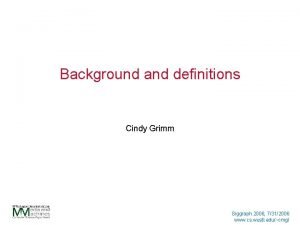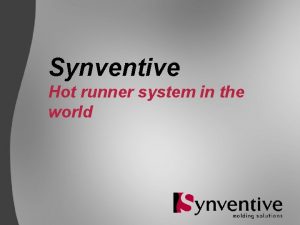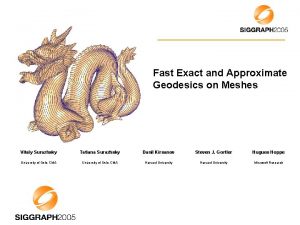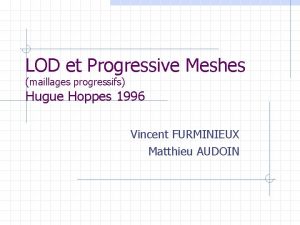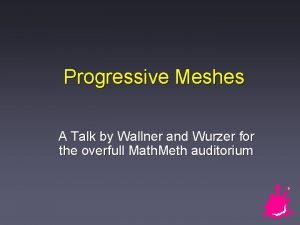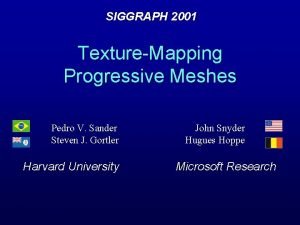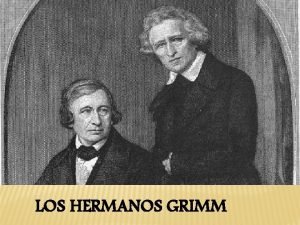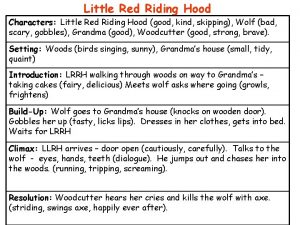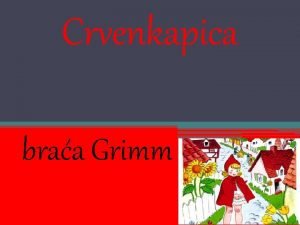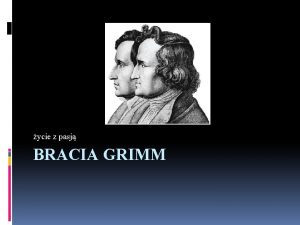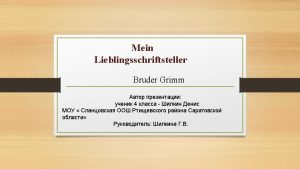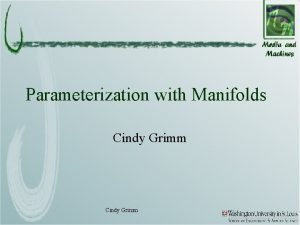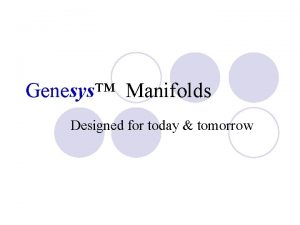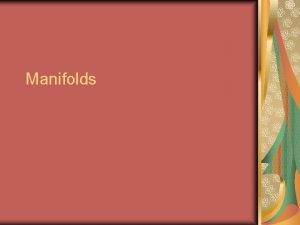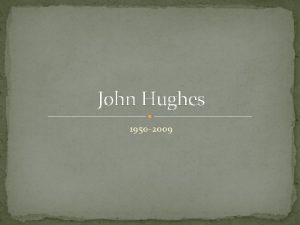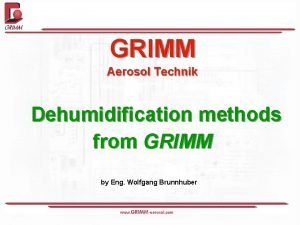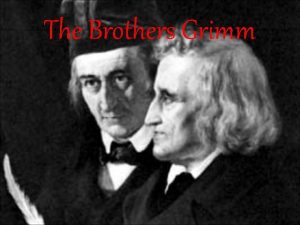Manifolds from meshes Cindy Grimm and John Hughes











- Slides: 11

Manifolds from meshes Cindy Grimm and John Hughes, “Modeling Surfaces of Arbitrary Topology using Manifolds”, Siggraph ’ 95 J. Cotrina Navau and N. Pla Garcia, “Modeling surfaces from meshes of arbitrary topology”, , Computer Aided Geometric Design, 2000 Lexing Ying and Denis Zorin, "A simple manifold-based construction of surfaces of arbitrary smoothness", Siggraph ’ 04 Siggraph 2005, 8/1/2005 www. cs. wustl. edu/~cmg/Siggraph 2005/siggraph. html

Overview • Goal: Construct a smooth, analytical surface from an input sketch mesh 2 Siggraph 2005, 8/1/2005 www. cs. wustl. edu/~cmg/Siggraph 2005/siggraph. html

Overview • Steps: • Build an abstract manifold using the connectivity of the mesh • Disks (charts), overlaps, transition functions • Assign geometry to each chart • Fit geometry to smooth approximation of sketch mesh (subdivision surface) • Blend to produce final surface 3 Siggraph 2005, 8/1/2005 www. cs. wustl. edu/~cmg/Siggraph 2005/siggraph. html

Goals A high-order surface construction • Important for geometric and numerical computation Desirable features • C¥ or Ck smoothness • At least 3 -flexibility at vertices • Closed-form smooth local parameterizations • Can handle arbitrary control meshes • Good visual quality • Easy to implement 4 Siggraph 2005, 8/1/2005 www. cs. wustl. edu/~cmg/Siggraph 2005/siggraph. html

Smoothness Ck smoothness • A standard goal in CAGD important for highaccuracy computation Computing surface properties • C 1 : needed for normal • C 2 : needed for curvatures, reflection lines; • C 3 : needed for curvature variation; 5 Siggraph 2005, 8/1/2005 www. cs. wustl. edu/~cmg/Siggraph 2005/siggraph. html

Flexibility Ability to represent local geometry • Property of surface construction method (dof) • Two-Flexibility: any desired curvature at any point 1 -flexible 6 2 -flexible Siggraph 2005, 8/1/2005 www. cs. wustl. edu/~cmg/Siggraph 2005/siggraph. html

Local parameterization Explicit smooth local parameterization • For any point, there is an explicit formula f(x, y) defining the surface in a neighborhood of this point Simplifies many tasks • Defining functions on surfaces • Integration over surfaces • Surface-surface intersections • Computing geodesics 7 Siggraph 2005, 8/1/2005 www. cs. wustl. edu/~cmg/Siggraph 2005/siggraph. html

Spline-based approach • Construct surface patch for each face • Patches share boundaries • Find smooth local parameterization for every point • Difficult to guarantee smoothness for points on patch boundaries 8 Siggraph 2005, 8/1/2005 www. cs. wustl. edu/~cmg/Siggraph 2005/siggraph. html

Manifold-based approach … … • Construct overlapping charts covering the mesh • Build local geometry approximating the mesh on each chart • Find blending function for each chart • Get the surface by blending local geometry 9 Siggraph 2005, 8/1/2005 www. cs. wustl. edu/~cmg/Siggraph 2005/siggraph. html

Visual smoothness • Large overlap regions • Short blend regions look like discontinuities • Chart embed function agreement • End conditions • Parameterization • Close to affine • No skew, stretch 10 Siggraph 2005, 8/1/2005 www. cs. wustl. edu/~cmg/Siggraph 2005/siggraph. html

Three techniques: Shared properties • • • Arbitrary topology, including boundary Number of charts determined by number of elements in the sketch mesh • E. g. , vertices, edges, faces Default disk shape/size • E. g. , n-sided unit polygon Transition functions only between adjacent elements • E. g. , a face and its vertices Blend function covers chart Embed functions • Subdivision surfaces are used to specify the desired geometry 11 Siggraph 2005, 8/1/2005 www. cs. wustl. edu/~cmg/Siggraph 2005/siggraph. html
